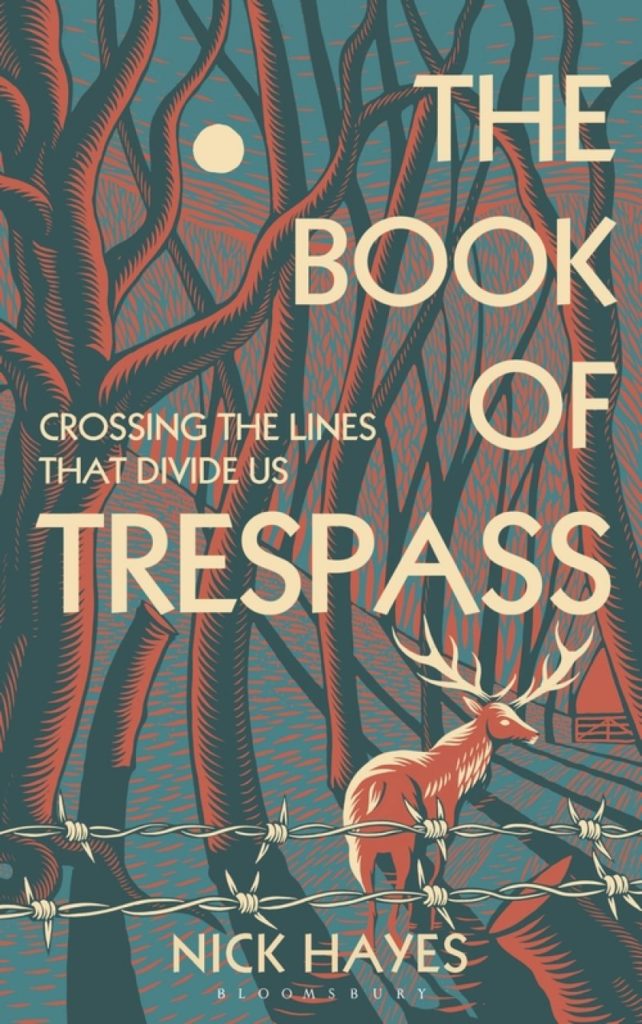As Helen Mort reviews Nick Hayes’s ‘The Book of Trespass’, published last month by Bloomsbury, thoughts turn to who owns what, and why.

Throughout the UK lockdown of 2020, many people across Britain turned to walking, local exploration as a means of connection, a way of looking outwards. But how much of the land that we love is accessible to us? In his timeless poem ‘A Man in Assynt’, Scottish writer Norman Maccaig asks:
Who owns this landscape?
Has owning anything to do with love?
When I turn the page around, Maccaig’s poem reminds me of a mountain range. In taut, spiky stanzas, he goes on to frame the same question differently:
Who owns this landscape? –
The millionaire who bought it or
the poacher staggering downhill in the early morning
with a deer on his back?
Who possesses this landscape? –
The man who bought it or
I who am possessed by it?
Nick Hayes’ The Book of Trespass offers a meditation on the same thorny questions, coming down firmly on the side of MacCaig, who concluded that landscapes like the north west of Scotland are masterless and intractable in any human terms. Sharing much of Maccaig’s dry wit, Hayes’ work is persuasive, polemical and exposes the hidden power dynamics that score through our maps, arguing that the root of social inequality is the uneven distribution of land.
Opening with the Kinder Trespass of 1939, the book unravels collective prejudice against migrants, travellers, the women of Greenham Common and connects it all back to the fallacy of possession. It reads as an expose of hidden Britain, looking at how wealth amassed by slavery enabled much of the property and and division of English land.
Hayes traces the idea of ownership back to the point when humans turned from nomadism to a more static, agricultural existence and he maps the intellectual history of property rights from Aristotle to Hobbes and beyond, how it snowballed into modern Britain, a society where the migration crisis iterates a ‘cult of exclusion’, where we exhibit a ’simultaneous fear and fascination’ with un-rootedness and where English land is riven by a ‘passive apartheid’. He rails against walls as a ‘technology of division’:
There are boundaries in nature. There are rivers, forests, escarpments, ravines and mountain ranges…but these boundaries are in fact areas of transaction. The notion that a perimeter should be impenetrable is a human contrivance alone.
MacCaig was famously suspicious of that contrivance too. But he extended his suspicion to the act of writing itself, loathing the pathetic fallacy and interrogating his own metaphors, implying that the very act of comparison can be a human imposition, a means of exerting control over the natural world. As I read The Book of Trespass, I found myself considering the polemical text as an act of subtle ownership, how a work of art can put boundaries around its subject. In the burgeoning fields of nature writing and ‘place writing’, there are intellectual fences to be climbed, claims staked and lines drawn. When we publish, we stake a claim.
Hayes tries to avoid the starkness of this, I think, by adopting a meandering structure which mimics the nature of trespass and resists the idea of ownership over a subject. The chapters are each named after creatures — badger, fox, even cockroach — and we are encouraged to follow where animals lead, descriptions of Hayes’ journeys (by foot and by kayak) mixed with evidence, debate and opinion. Reading The Book of Trespass is a visual, sensory experience as well, each section illustrated with dells, lakes, parks and animals. The stag of the final chapter represents a noble forest beast but also the Sheffield Trees Action Group who were successful in their bid to save city trees. Such is the brilliant metamorphosis of trespassing. Along with Hayes’ generosity to other sources — quoting poets and artists as often as academics — this gives a feeling of inclusivity, of being invited along on the journey.
The writing itself is enchanting, laced with rich imagery and phrases which make us see familiar landmarks anew. Fallen oaks are ‘ossified squids, trailing their tentacles across the grass.’ Woods are ‘an empty marquee’. Winter sky is ‘a blank cinema screen projected into an empty theatre’. I laughed out loud at the brilliant observation of a dog sniffing piss, ‘checking his weemails’. By there end of the book, I wanted to take a midnight walk across a grouse moor, or take my chance with the fences around an estate, or swim down a river, ignoring the boundaries on the banks.
*
The Book of Trespass: Crossing the Lines That Divide England is out now and available here, priced £18.00.
Helen Mort is a writer of poetry, fiction, and creative non-fiction, as well as a teacher of creative writing. See her previous pieces for Caught by the River here. You can follow her on Twitter here.